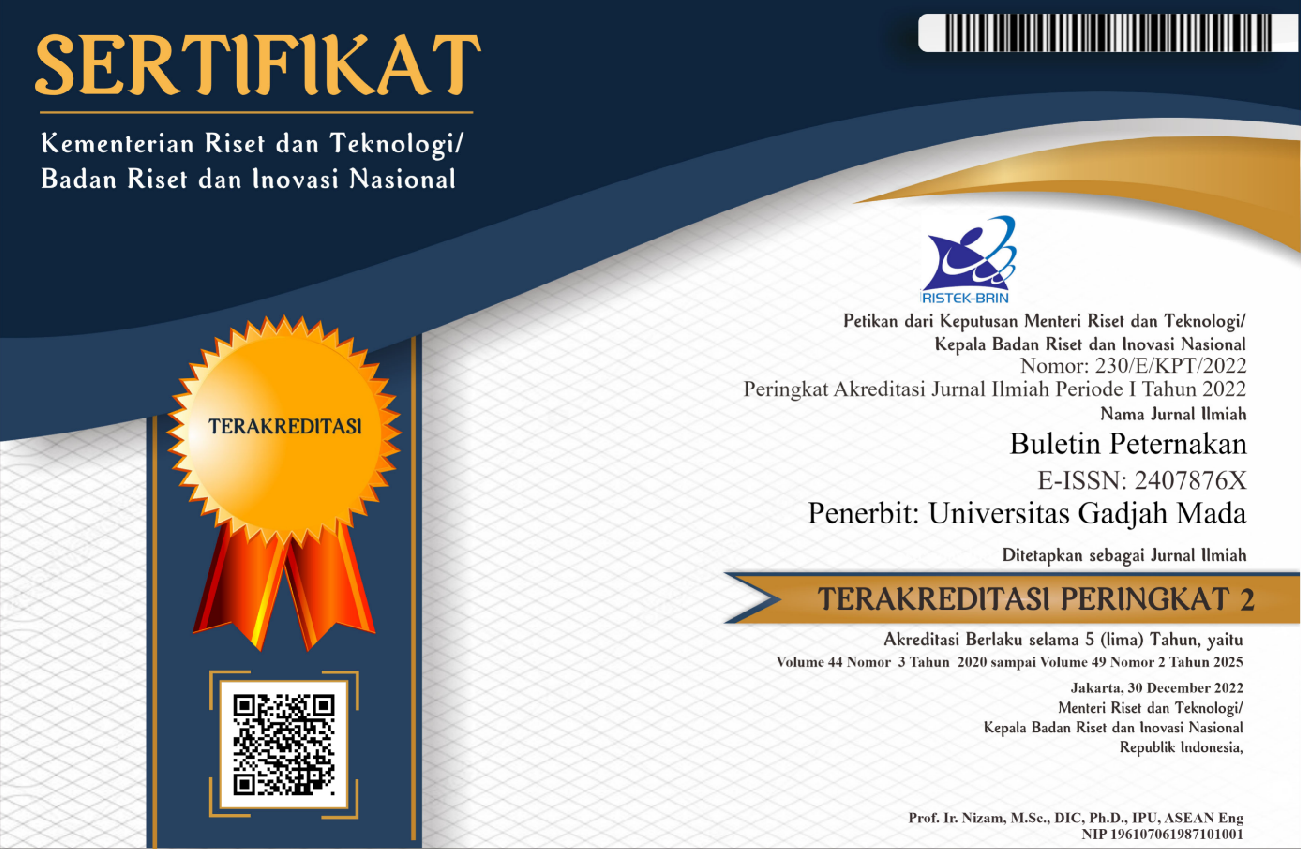The Strategy of the Sustainable Livelihoods for Beef Farmers in Bima Regency after the Flood Disaster in April 2021
Kharismafullah Kharismafullah(1*), Siti Azizah(2), Agus Budiarto(3)
(1) Faculty of Animal Husbandry, Brawijaya University, Malang, 65145, Indonesia
(2) Faculty of Animal Husbandry, Brawijaya University, Malang, 65145, Indonesia
(3) Faculty of Animal Husbandry, Brawijaya University, Malang, 65145, Indonesia
(*) Corresponding Author
Abstract
The purpose of this study is to know the sustainable livelihood strategies of beef cattle farmers at the Bima region after the flood disaster. The research method used in this study is descriptive qualitative. The sampling method used the purposive sampling technique on 265respondents beef cattle farmersin the four research districts and 22 respondents as key informants consisting of the Head of the Livestock and Animal Health Service of Bima Regency, the Head of the West Nusa Tenggara Province (NTB) Forestry Service, the Head of the Bima Regency Agriculture Service, the Head of Technical Implementation Unit (UPT) of Animal Husbandry in the 4 research districts, the Head of agricultural UPT in the 4 sub-districts of the research location, 10 village heads in the 4 sub-districts where the research is located, and the head of the livestock group. Data collection methods consisted of field observations, structured interviews using questionnaires, in-depth interviews using snowball sampling techniques, and secondary data accessed at Bank Negara Indonesia (BNI) Bima Branch. The research locationconsists of 4 districts, among others: the Districts of Bolo, Madapangga, Woha, and Monta. The research location was selected based on the sub-districts that were worst affected by the floods. Primary data collection methods are observation and interviews while the secondary data collection method is by accessing the Department of Animal Husbandry and Animal Health in the Bima region and BNI. Data analysis using descriptive qualitative. The results of the research on sustainable livelihood strategies for beef cattle farmers to respond to flood disaster vulnerability are by implementing a strategy of utilizing available resource assets around the location of the livestock business which consists of human resource assets, natural resources, economic resources, physical resources and natural resources, power, social resources
Keywords
Full Text:
PDFReferences
Andarwati, S., Rijanta, R. Widiati, and Y. Opatpatanakit. 2017. Strategi Penghidupan Peternak Sapi Perah Di Lereng Selatan Gunungapi Merapi Pasca Erupsi 2010. Buletin Peternakan 41: 91. https://Doi.Org/10.21059/Buletinpeternak.V41i1.12768
Badan Penanggulangan Bencana Daerah (BPBD) Kabupaten Bima. 2021. Dampak Bencana Banjir di Kabupaten Bima Tahun 2021.
Badan Pusat Statistik (BPS) Kabupaten Bima. 2021. Statistik Daerah Kabupaten Bima tahun 2021. ISSN : 2503-4022; Nomor Publikasi : 52060.5206.
Bank Negara Indonesia (BNI). 2021. Daftar Penerima Pinjaman Dana Kredit Usaha Rakyat (KUR) di Kabupaten Bima. Cabang Bima.
Department for International Development (DFID). 1999. Sustainable Livelihoods Guidance Sheets. The Department For International Development, Glasgow, United Kingdom.
Hapsoro, A. W. and I. Buchori. 2017. Kajian kerentanan sosial dan ekonomi terhadap bencana banjir. Jurnal Teknik PWK 4: 542–553.
Ikhsanuddin, M. D. G. 2017. Penentuan konsentrasi optimum selulosa ampas tebu (baggase) dalam pembuatan film bioplastik. Skripsi, Universitas Islam Negeri Alauddin Makassar. pp. 21–22.
Kodoati, G., P. O. V. Waleleng, J. Lainawa, and D. R. Mokogouw. 2016. Analisis potensi sumberdaya alam, tenaga kerja, pertanian dan perkebunan terhadap pengembangan peternakan sapi potong di Kecamatan Eris Kabupaten Minahasa. Zootek 34: 15–26.
Meliani, D. 2009. Daya dukung lingkungan kecamatan Rasau Jaya berdasarkan ketersediaan dan kebutuhan lahan. Jurnal Mahasiswa Teknik Lingkungan Untan 1997: 1–10. jurnal.untan.ac.id/index.php/jmtluntan/article/viewFile/1806/.
Pavilawati, D. A. 2020. Analisis keberlangsungan usaha pembuatan taoge ditinjau dari sustainable livelihood framework (Studi kasus di Desa Penambangan, Kecamatan Balongbendo, Kabupaten Sidoarjo). Skripsi, Program Studi Ilmu Ekonomi, Fakultas Ekonomi dan Bisnis, Universitas Islam Negeri Sunan Ampel.
Prawira, H. Y., Muhtaradin and R. Sutrisna. 2015. Potensi pengembangan peternakan sapi potong di Kecamatan Tanjung Bintang Kabupaten Lampung Selatan. Jurnal Ilmiah Peternakan Terpadu 3: 250-255.
Sebastian, S., J. Lassa, and A. Ramli. 2007. Kerangka Penghidupan Berkelanjutan Sustainable Livelihood Framework. pp.31.
Syamsu, J. A. and U. Hasanuddin. 2020. Potensi dan Daya Dukung Jerami Padi sebagai Sumber Pakan. ISBN 978-602-70032-5-5. https://www.researchgate.net/publication/341251468
Article Metrics
Refbacks
- There are currently no refbacks.

This work is licensed under a Creative Commons Attribution-ShareAlike 4.0 International License.
Buletin Peternakan (Bulletin of Animal Science) Indexed by:

This work is licensed under a Creative Commons Attribution-ShareAlike 4.0 International License.









